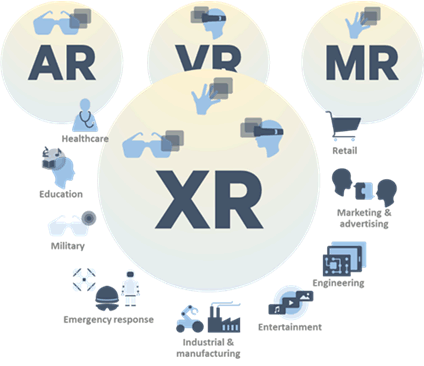Content for TR 26.928 Word version: 17.0.0
0…
4…
4.1.2…
4.2…
4.3…
4.4…
4.5…
4.6…
4.6.7
4.7…
4.9…
5…
6…
7…
8
A…
A.4…
A.7…
A.10…
A.13
A.14
A.15
A.16…
A.19…
A.22…
4 Introduction to Extended Reality
4.1 XR Terms and Definitions
4.1.1 Different Types of Realities
...
...
4 Introduction to Extended Reality p. 12
4.1 XR Terms and Definitions p. 12
4.1.1 Different Types of Realities p. 12
The scope of this clause is the introduction of eXtended Reality (XR) to 3GPP services and networks. eXtended Reality (XR) is an umbrella term for different types of realities as shown in Figure 4.1-1. The figure also shows different application domains of XR such as entertainment, healthcare, education, etc. The different terms are defined in the following, reusing and extending some definitions from TR 26.918.

Virtual reality (VR) is a rendered version of a delivered visual and audio scene. The rendering is designed to mimic the visual and audio sensory stimuli of the real world as naturally as possible to an observer or user as they move within the limits defined by the application. Virtual reality usually, but not necessarily, requires a user to wear a head mounted display (HMD), to completely replace the user's field of view with a simulated visual component, and to wear headphones, to provide the user with the accompanying audio. Some form of head and motion tracking of the user in VR is usually also necessary to allow the simulated visual and audio components to be updated in order to ensure that, from the user's perspective, items and sound sources remain consistent with the user's movements. Additional means to interact with the virtual reality simulation may be provided but are not strictly necessary.
Augmented reality (AR) is when a user is provided with additional information or artificially generated items or content overlaid upon their current environment. Such additional information or content will usually be visual and/or audible and their observation of their current environment may be direct, with no intermediate sensing, processing and rendering, or indirect, where their perception of their environment is relayed via sensors and may be enhanced or processed.
Mixed reality (MR) is an advanced form of AR where some virtual elements are inserted into the physical scene with the intent to provide the illusion that these elements are part of the real scene.
Extended reality (XR) refers to all real-and-virtual combined environments and human-machine interactions generated by computer technology and wearables. It includes representative forms such as AR, MR and VR and the areas interpolated among them. The levels of virtuality range from partially sensory inputs to fully immersive VR. A key aspect of XR is the extension of human experiences especially relating to the senses of existence (represented by VR) and the acquisition of cognition (represented by AR).
Other terms used in the context of XR are Immersion as the sense of being surrounded by the virtual environment as well as Presence providing the feeling of being physically and spatially located in the virtual environment. The sense of presence provides significant minimum performance requirements for different technologies such as tracking, latency, persistency, resolution and optics. For more details, refer to clause 4.2.
Other relevant terms in the context of XR experiences are:
- Parallax is the relative movement of objects as a result of a change in point of view. When objects move relative to each other, users tend to estimate their size and distance.
- Occlusion is the phenomena when one object in a 3D space is blocking another object from being viewed.
- Head-mounted displays for Virtual Reality,
- Optical see-through glasses and camera see-through HMDs for Augmented and Mixed Reality,
- Mobile devices with positional tracking and camera.